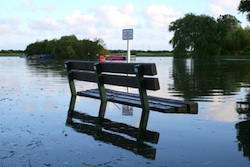 With any land, property development, purchase or disposal it is vital to undertake a range of due diligence checks at the outset to help prevent you from discovering any unforeseen obstacles or issues further into the process. For instance, have you undertaken checks to research into past land usage of the plot in question? Is there any potential flood risk, land contamination, land use constraints, underground utilities, or even ancient burial ground that may not be visible to the naked eye, but could have an impact on your overall plans?
With any land, property development, purchase or disposal it is vital to undertake a range of due diligence checks at the outset to help prevent you from discovering any unforeseen obstacles or issues further into the process. For instance, have you undertaken checks to research into past land usage of the plot in question? Is there any potential flood risk, land contamination, land use constraints, underground utilities, or even ancient burial ground that may not be visible to the naked eye, but could have an impact on your overall plans?
The highly publicised discovery of King Richard III’s remains under a car park in Leicester is just one rather extreme example of what can be identified in the most unlikely of locations. Due diligence is therefore key to ensure you know exactly what you are dealing with before a project commences.
In today’s digital world, planners, architects, surveyors and developers have access to a wealth of online data sources that support the due diligence process as well as feasibility studies, environmental impact reports or the wider planning process.
Research services and data sources are now more accessible than ever, meaning that everything from historic maps, environmental reports or geological data through to historic planning information can be quickly sourced. This means more informed decisions can be made or potential issues highlighted as early as possible.
So what issues should be researched as part of any property transaction/development, and where can you start looking for initial guidance? Here are five initial areas that I believe should be at the top of the due diligence agenda:
Land Use Constraints
A first step is to determine whether the land or property has any restrictions in place, which may confine the extent or type of use or development that can occur. For example, this includes areas deemed to be of natural importance, such as a conservation area or an Area of Outstanding Natural Beauty. Understanding the type and location of these designated areas is important during any planning process.
Natural England, Scottish Natural Heritage, Countryside Council for Wales, English Heritage and Historic Scotland all have a wealth of data, in addition to centralised online resources such as Promap, which collates data from a range of sources and so reduces the need to have to contact individual suppliers.
Flooding
According to the Environment Agency, more than five million properties in England and Wales are at risk of flooding from river, sea, surface and ground water. A flood advice line and online warnings are provided by the Agency, in addition to flood risk guidance as part of the planning process. Currently, it doesn’t provide information related to ground or surface water flooding, which accounts for over 50 per cent of flooding in the UK . However this can be accessed from flood risk specialists. Seek advice to understand the potential risks as use, designs, and methods of construction may need to be altered and protection measures investigated and costed if a risk is present on the site.
Land Contamination
Accessing historical mapping data is one way of extrapolating information regarding past activities that took place on the land. By analysing a historic map, you can quickly identify former industrial buildings, churches, quarries or similar that was located on the land. Councils and commercial providers also hold a range of data on potential sources of contamination. In fact, councils maintain registers that illustrate when legal action has been taken on contaminated land or for those sites where contamination may be present. Both councils and commercial entities hold data on historic land use, planning history, pollution incidents, details of closed landfill sites, site-specific reports on investigation and remediation and other related matters.
Rights of Way
Public rights of way can potentially create restrictions from a planning or development point of view, so always check if they impact on your proposed site. The data is derived from the 'Public Rights of Way' and 'Other Public Access' sections of Ordnance Survey Explorer Maps, which have been taken from local authority definitive maps and any later amendments.
As rights of way are not always clearly defined on the site itself and are susceptible to change, it is important to check with the relevant local authority for the very latest information.
Ground Stability
Having an accurate picture of any ground stability issues surrounding a site is important. Data is available that not only provides a precise picture of historical subsidence or heave (a a sideways displacement in a fault), but even potential seismic activity. Risks can also arise from past coal mining activities and as a result, coal mining searches are available from the Coal Authority, which are ideal for anyone planning a development on land located near to a former mining area.
There is business here for surveyors and developers to add value to clients’ property proposals. You could be held to account if you do nothing and risks are identified at a later stage of the process, so it does pay to do your due diligence homework at the outset.
About the Author
 Stewart Cooper is a Chartered Surveyor and Director of Property at Argyll Environmental, a Landmark Information Group business. He is a member of the RICS's Flooding Working Group.
Stewart Cooper is a Chartered Surveyor and Director of Property at Argyll Environmental, a Landmark Information Group business. He is a member of the RICS's Flooding Working Group.
Have you any commercial property events you'd like to tell us about? It could be networking, exhibitions, seminars, industry lunches or sporting fixtures. We will list them for free. Just email newsdesk@propnews.co.uk with the following details: Event name, date, time, venue, cost, booking info and a brief description of the event.
To list your property job vacancies on Property News. Email: richenda@propnews.co.uk.